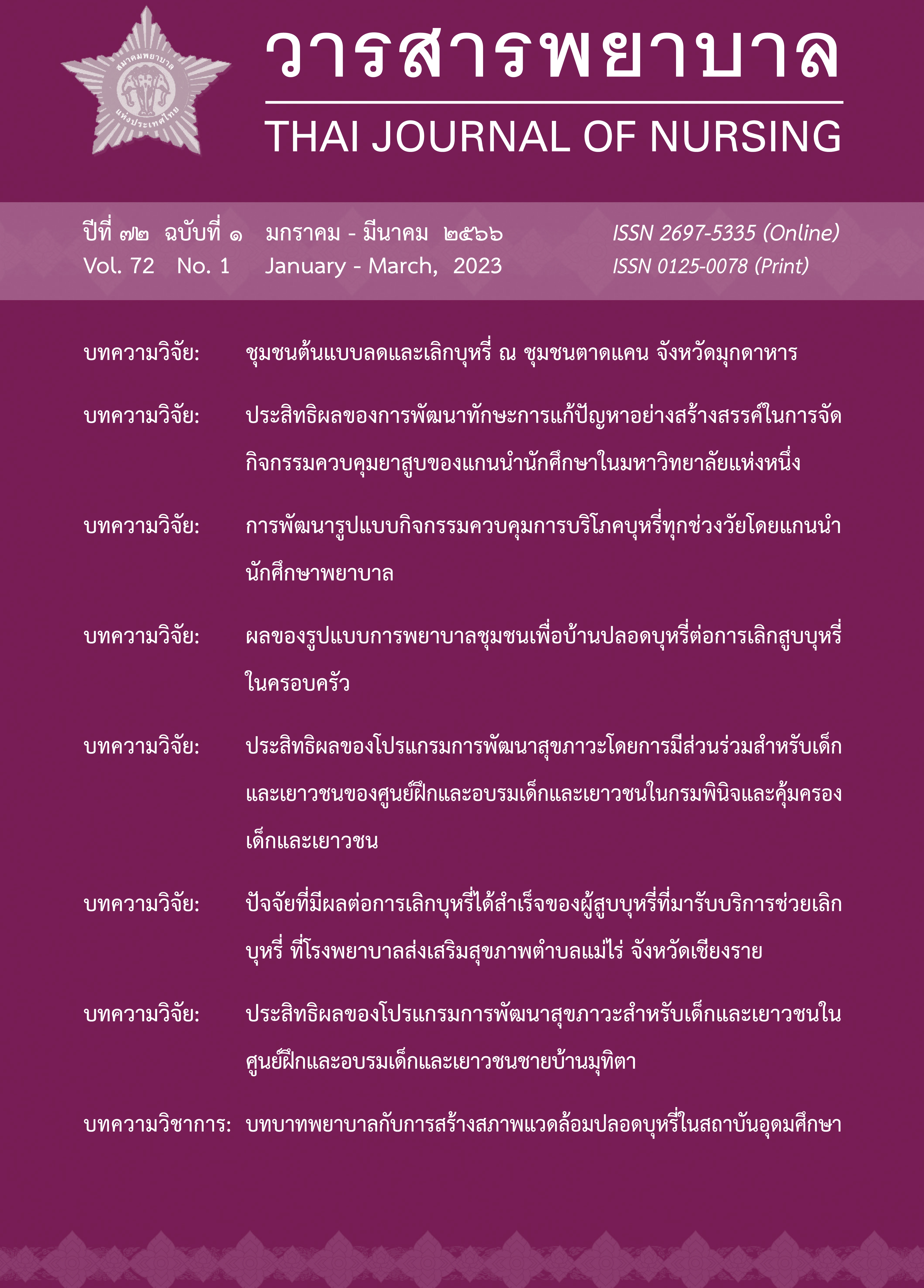Effectiveness of participatory wellbeing development program for youths of Juvenile Practice and Training Center in the Department of Juvenile Observation and Protection
Main Article Content
Abstract
The objective of this quasi-experimental research was to examine effectiveness of participatory wellbeing development program for youths of Juvenile Practice and Training Center in the Department of Juvenile Observation and Protection. The sample of 187 youths from five Juvenile Practice and Training Centers was voluntarily selected. Research tools were the wellbeing assessment and the participatory wellbeing development program including food consumption, exercise and physical activity, stress management and emotional coping, smoking cessation and smoke-free environment. Data analysis were performed using descriptive statistics and paired t-test. Results revealed that after implementing the participatory wellbeing development program, youths had significantly better wellbeing than before the implementation at p < .05.
Article Details

This work is licensed under a Creative Commons Attribution-NonCommercial-NoDerivatives 4.0 International License.
References
กระทรวงยุติธรรม. กรมพินิจและคุ้มครองเด็กและเยาวชน (2564). สถิติเด็กและเยาวชนในศูนย์ฝึกและอบรมเด็กและเยาวชนในสังกัดกรมพินิจและคุ้มครองเด็กและเยาวชน กระทรวงยุติธรรม. มปท.
กระทรวงสาธารณสุข กรมสนับสนุนบริการสุขภาพ กองสุขศึกษา. (2561). การเสริมสร้างและประเมินความรอบรู้ด้านสุขภาพและพฤติกรรมสุขภาพ. โรงพิมพ์ชุมนุมสหกรณ์การเกษตรแห่งประเทศไทย.
กระทรวงสาธารณสุข กรมอนามัย สำนักส่งเสริมสุขภาพ. (2562). รายงานการสำรวจภาวะสุขภาพนักเรียนในประเทศไทย พ.ศ. 2558. สำนักงานกิจการโรงพิมพ์องค์การสงเคราะห์ทหารผ่านศึก.
ณภัสวรรณ ธนาพงษ์อนันท์ และ ญาณภัทร สีหะมงคล. (2564). การสร้างเกณฑ์ปกติสมรรถภาพทางกายที่สัมพันธ์กับทักษะของนิสิตสาขาวิทยาศาสตร์การกีฬา คณะศึกษาศาสตร์ มหาวิทยาลัยมหาสารคาม. วารสารการวัดผลการศึกษา มหาวิทยาลัยมหาสารคาม, 27(2), 99 -115.
วนัญญา แก้วแก้วปาน. (2564). การศึกษาความเครียดของนักเรียนวัยรุ่นชั้นมัธยมศึกษาปีที่ 6 โรงเรียนสังกัดสำนักงานเขตพื้นที่การศึกษามัธยมศึกษาเขต 10 จังหวัดสมุทรสงคราม. วารสารศึกษาศาสตร์ มหาวิทยาลัยบูรพา, 32(2), 13-28.
ศุภลักษณ์ ศรีธัญญา, วนลดา ทองใบ, และ จีราภรณ์กรรมบุตร. (2562). ผลของโปรแกรมปรับเปลี่ยนพฤติกรรมตามแผนต่อพฤติกรรมการบริโภคและการทำกิจกรรมทางกายของเด็กวัยเรียนตอนปลายที่มีน้ำหนักเกิน. วารสารพยาบาลศาสตร์ จุฬาลงกรณ์มหาวิทยาลัย, 31(2), 85-97.
สำนักงานกองทุนสนับสนุนการสร้างเสริมสุขภาพ. (2563). จับตาทิศทางสุขภาพคนไทย ปี 2563. สำนักพัฒนาภาคีสัมพันธ์และวิเทศสัมพันธ์ สำนักงานกองทุนสนับสนุนการสร้างเสริมสุขภาพ. https://resourcecenter.thaihealth.or.th/files/90จับตา%2010%20พฤติกรรมสุขภาพคนไทย%20ปี%2063.pdf
Amornsriwatanakul, A., Lester, L., Bull, F. C., & Rosenberg, M. (2017). Are Thai children and youth sufficiently active prevalence and correlates of physical activity from a nationally representative cross-sectional study. International Journal of Behavioral Nutrition and Physical Activity, 14(72), 1-9.
Bandura, A. (1982). Self-efficacy: Mechanism in human agency. American Psychologist, 37(2), 122-147.
Battaglia, C., di Cagno, A., Fiorilli, G., Giombini, A., Fagnani, F., Borrione, P., Marchetti, M., & Pigozzi, F. (2013). Benefits of selected physical exercise programs in detention: A randomized controlled study. International Journal of Environmental Research and Public Health, 10, 5683-5696.
Brusseau, T. A., Burns, R. D., & Hannon, J. C. (2018). Physical activity and health-related fitness of adolescents within the juvenile justice system. BioMed Research International, Article 9710714.
https://doi.org/10.1155/2018/9710714
Burns, R. D, Brusseau, T. A., Fu, Y., Myrer, R. S., & Hannon, J. C. (2016). Comprehensive school physical activity programming and classroom behavior. American Journal of Health Behavior, 40(1), 100-107. https://doi.org/10.5993/AJHB.40.1.11
Chotbenjamaporn, P., Haruhansapong, V., Jumriangnt, P., Pitayarangsarit, S., Agawal, N., & Garg, R. (2017). Tobacco use among Thai students: Results from the 2015 global youth tobacco survey. Indian Journal of Public Health, 61(S1), 40-46.
Damodaran, D., & Paul, K. V. (2015). Stress management among adolescents. The International Journal of Indian Psychology, 3(1), 104-111.
Gándola, D. (2020). The power of self-efficacy: helping your children believe in themselves. Family Perspectives, 2(1), 1-4.
Osteras, B., Sigmundason, H., & Haga, M. (2015). Perceived stress and musculoskeletal pain are prevalent and significantly associated in adolescents: An epidemiological cross-sectional study. BMC Public Health, 15(1081), 1-10.
World Health Organization. (2019). WHO report on the global tobacco epidemic 2019: Offer help to quit tobacco use. https://www.who.int/publications/i/item/9789241516204


